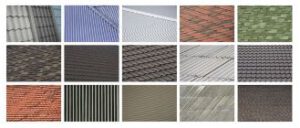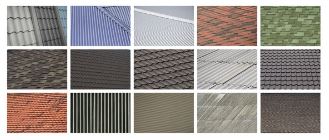Choosing the right Roof Materials is an important decision when building a home. You must consider wood shingles, slate, clay tile, and interlocking panels. If you are considering an entirely new roof for your home, learn more about each option and choose the best one. You can also choose from various colors and patterns, ensuring your home looks beautiful for years. Here are the most popular Roof Materials:
Wood Shingles
When deciding between different types of roof materials, consider the benefits of wood shingles. In addition to its aesthetics, wood shingles are naturally resistant to ultraviolet rays, insects, and fungi. In addition to their durability, wood shingles can be stained, oiled, or painted to create a unique and beautiful roof. These advantages can make wood shingles an excellent choice for roof construction. To learn more about the benefits of wood shingles, keep reading.

The main advantage of wood shingles over other materials is their durability. Typically, wood is a great insulator, making a home warmer in winter and cooler in summer. In addition, wood shakes are extremely durable against wind damage, which is a common issue with asphalt shingles. Redwood and cedar shakes are particularly durable, improving the stability of the roof deck. But they do have some disadvantages.
The most common type of wood for roofing is western red cedar, which is weather resistant, durable, and abundant. While some other wood species are available, there is a limited amount of wood in the country. If you’re thinking about wood shingles for your roof, you should consider the climate of your region. If your area receives high winds, you should avoid wood shingles unless you live in a dry climate.
Slate
Slate roofs were traditionally used on castles and other military structures, but they began to become popular in America in the early 1600s. Slate quarries were opened in some parts of the country in 1734. By the 1800s, slate was widely available for residential roofs, and it had become affordable. However, there are several important considerations before deciding on a slate roof for your home. Below is a brief look at the pros and cons of slate roofing.
Slate roofs are typically graded according to thickness and length. The thickness of slates is thickest at the eaves. However, there is a range of thicknesses from thin three-fourths of an inch to a full one-inch. Thickness is another important factor since thicker slates are more expensive to purchase and install. In addition to thickness, other factors to consider include the size of each piece, texture, and shape. Unless otherwise specified, slates are rectangular.
Slate roof materials are environmentally friendly, since they use all-natural materials, and their lifespan is far greater than asphalt shingles. Asphalt shingles must be replaced every 15 to 25 years, while a slate roof can last for a century or more. Roofing materials are a major source of waste in the landfill, and roofing materials are responsible for five percent of all garbage. Choosing a slate roof can also be a wise investment because it will last for generations.
Clay Tile
Compared to asphalt shingles, clay tiles have lower maintenance requirements, which can lower the overall cost of ownership. While asphalt shingles can last for over 20 years, they require specialized maintenance, and they’re prone to cracking and rot. In addition to their low maintenance costs, clay tiles are fire and insect-resistant. These resilient, lightweight roofs allow air to circulate beneath them, regulating rooftop temperatures.
Another benefit of choosing clay tile as a roofing material is that it resists extreme weather conditions and harmful UV rays from the sun. Because clay tiles are individually installed, they create airspace around them that acts as a thermal barrier, reducing heat transfer and peak load demands. This airspace also helps maintain a consistent indoor temperature. Therefore, a clay tile roof is both beautiful and energy-efficient. But its price is high – you can expect it to cost more than a traditional asphalt roof.
Besides their durability, clay roof tiles are also easy to install. Unlike asphalt shingles, clay tiles are available in traditional and architectural forms. Installing them is straightforward, and clay tiles come in a wide range of colors and sizes. If you’re unsure how to install clay tiles, consider hiring a professional. This way, you’ll avoid wasting time and money on mistakes. You’ll be assured of the durability and aesthetic appeal of your clay roof for decades to come.
Interlocking Panels
Interlocking panels for roofs are a great way to combine the best of several materials. Some of them mimic traditional roofing materials like slate, clay, and shingles. These roof panels can withstand heavy rainfall, 120 mph winds, uplifting, and freeze-thaw cycles. In wet climates, stone-coated steel roofs can be an economical and sustainable option. While slate roofing is an elegant choice, it is extremely heavy, hard to install, and easily broken when stepped on.
In one embodiment of the invention, panels interlock along an abutting edge. In FIG. 2, the edge of a panel is indicated by an arrow 38. A twenty-foot add-on room would require five panels 32 in edge-to-edge relation. Alternatively, the add-on room could be as wide as sixteen feet. Since each panel would be sixteen feet long, the total length would be sixty-two feet.
One method of assembling interlocking panels for roof materials is to attach the panels with the help of interlocking means. These interlocking means can be used for both flat and pitched roofs. A continuous metal membrane that encases the panels can be used to make ridge caps and soffit flashings. The purpose of these panels is to protect buildings from extreme winds. For this reason, they can be used to provide additional insulation to buildings.
Stone Slabs
For many years, stone slab roofing was a popular choice for roofs on single-story homes. Traditionally, slabs were cut to size to cover the entire roof area and placed on top of stone or brick pillars, which supported the beams. Waterproofing was applied to the joints to protect them from the elements. Today, stone slab roofing is not an appropriate choice for multi-story office buildings, because the rate of urbanization will eventually deplete local supplies.
Traditional floor slabs were typically made of logs of pine or Sabina wood. They were sometimes rectangular and covered the space between them. The materials used in the space between the logs varied according to the location and purchasing power of the owner. A wooden beam was laid over the log structure, a few centimeters thick and long enough to cover multiple beams. Then, paving was placed over it.
Roofing with stone slabs has several benefits. While they are relatively light, they are difficult to install and tend to weigh down the foundation of the building. This makes them an excellent choice for heritage buildings or as a decorative feature. Stone slab roofs are also virtually storm-proof and provide excellent insulation. However, because stone slabs are heavy and complex, some types of roofing will require special permission or structural engineering. So it is recommended that you get advice from a professional before you install stone slab roofs on a building.
Cedar Shakes
Many people are skeptical about the durability of cedar shakes as roof materials. The fact is that cedar is far more durable than asphalt shingles and has a lifespan of 50 years. Another great benefit of cedar shake roofs is that they are energy-efficient. They are excellent insulators and outperform most other types of roofing materials. However, there are a few things you need to know before getting cedar shakes installed on your roof.
Despite the durability of cedar shingles, there are some important things you should know before going in for this type of roofing. First, cedar shakes are not uniformly cut. They have more variation in size and shape and therefore add a more rustic look to a home. As a result, they require a skilled roofer to install them properly, otherwise, they may cause gaps and leaks. A roofing company has extensive experience installing cedar shake roofs and has been in business for over thirty years.
The second important factor to consider when choosing cedar shakes as a roofing material is how much maintenance you are willing to commit to the project. Like any other type of roofing, cedar shakes require regular maintenance. You need to keep your home clean to prevent accumulated debris and moisture. The gutters should also be kept clean so water doesn’t pool in them. If you want to avoid the maintenance required by cedar shake roofs, it is best to go with a contractor with a warranty that covers the entire project.


